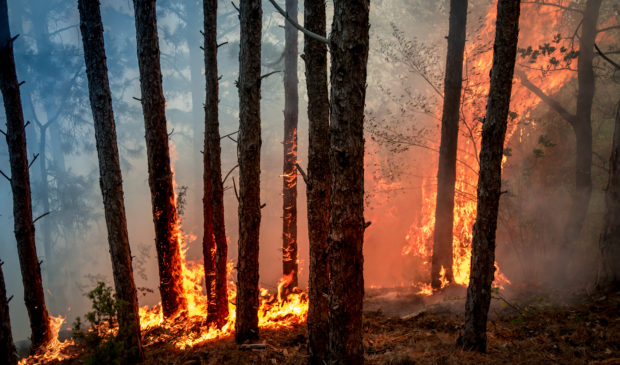Newsletter Signup
The Austin Monitor thanks its sponsors. Become one.
Most Popular Stories
- Austin to Manor Trail now complete, linking suburb to citywide trail network
- Camp Mabry as a park? Author Lawrence Wright proposes new use for military base
- Left waiting: Rally Austin pushes for city action on four sites ID’d for redevelopment
- Class action lawsuit targets Austin taxes over Project Connect
- Critics still say hydrogen gas plant would be a dealbreaker in Austin Energy Resource Generation Plan
-
Discover News By District

City highlights resilience measures during Wildfire Awareness Month
Wednesday, June 1, 2022 by Kali Bramble
The city of Austin is no stranger to irregular weather patterns, with some predicting that near-record May temperatures foreshadow an unusually hot and dry summer. With temperatures rising, staff members across a number of city departments are bolstering their defenses against the threat of wildfires.
In lockstep with nationwide awareness campaigns, City Council declared May Wildfire Awareness Month, voicing its commitment to ramp up resilience measures as the risk of disaster increases. In solidarity, Austin Water Wildland Conservation staff stopped by last Wednesday’s Austin Water Oversight Committee meeting for an update on mitigation strategies.
“In recent months, we’ve experienced several red-flag days and periods of extreme risk. These are also reminiscent of the conditions that we experienced during the 2011 wildfire season that so deeply impacted Central Texas,” said Mayor Pro Tem Alison Alter. “I’m sure I’m not alone in taking those red-flag days as a warning that we must heed to ensure we do everything in our power to keep our community safe and prepared for the next wildfire event.”
Austin’s combination of natural vegetation and urban development makes it uniquely susceptible to wildfire events, with financial analytics service CoreLogic ranking it the fifth-highest-risk city in the nation following California cities Los Angeles, Riverside, San Diego and Sacramento. With nearly 61 percent of Travis County’s homes within 150 feet of wildlands spanning over 40 acres (as well as structures a mile and a half from 750-plus-acre tracts), much of the city’s mitigation strategies have targeted these wildland-urban interface areas.
While the Wildland-Urban Interface Code passed by City Council last year works to more safely regulate development, Austin Water has also taken on the role of stewarding over 48,000 acres in environmental preserves and city-owned easements. Central to these efforts are shaded fuel breaks that thin out shrubby underbrush and lower tree branches and controlled burning programs that eliminate dried grasses. Both aim to reduce the amount of combustible brush, called “fuel,” that lay the path for wildfires.
Though Austin’s Wildland Conservation Division has made steady progress in its stewardship, topographical features such as steep terrain and thick vegetation make it challenging to get crews both in and out, and regulations protecting the endangered golden-cheeked warbler restrict such operations to a six-month window each year. Furthermore, these tactics pose risks, as evidenced by the Rolling Pines fire earlier this year that sprang from a prescribed burn gone awry.
Still, Austin Water continues to collaborate with other city departments on a number of fire prevention strategies, developing maps to help first responders navigate topographically challenging wildlands and protocols for utility workers to safely install infrastructure in sensitive areas. Staffers also continue to partner with Austin Energy to build safer electric infrastructure, a project especially pertinent in the aftermath of the 2011 Bastrop County Complex fire that destroyed 1600 homes and likely began from power line sparks.
“2011 was a severe and visceral wake-up call to the threat of wildfire in our community,” said Austin Fire Department Assistant Chief Andre de la Reza. “No longer were we ready to just sit in the mornings and read about fires burning up the West Coast. It was now a threat on our doorstep.”
Those hoping to take their own measures for wildfire preparedness can visit Austin’s Wildfire Hub for a number of resources on disaster prevention and education.
The Austin Monitor’s work is made possible by donations from the community. Though our reporting covers donors from time to time, we are careful to keep business and editorial efforts separate while maintaining transparency. A complete list of donors is available here, and our code of ethics is explained here.
You're a community leader
And we’re honored you look to us for serious, in-depth news. You know a strong community needs local and dedicated watchdog reporting. We’re here for you and that won’t change. Now will you take the powerful next step and support our nonprofit news organization?





